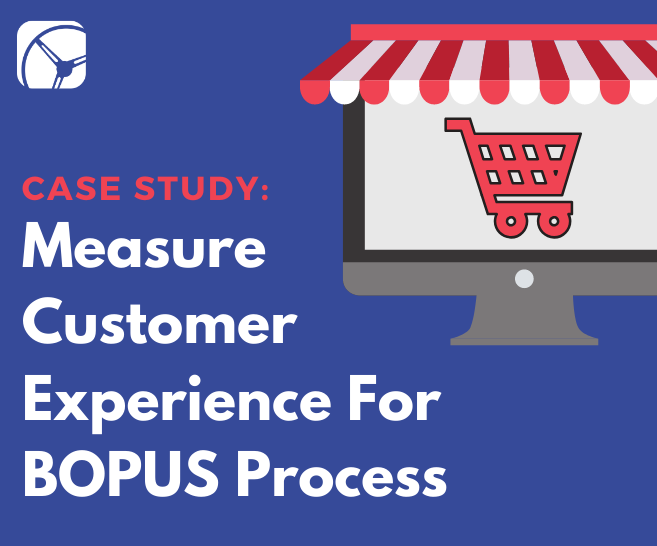Put yourself in the shoes of a customer. You are presented with a multitude of options when buying an item. Do you want to buy your goods online or in-store? If bought online, will you pick it up in-store (BOPUS) or do you want your purchased item to be delivered to your home?
Understanding a shopper’s behavior is critical in shaping the perfect online or in-store customer experience (CX). Instead of guessing and assuming what customers want, why not use data to validate the key business decisions that go into developing a store layout, marketing messaging, online shopping capabilities, promotions, and more?
Recently, our retail market research company partnered with a (1) leading department store and (2) multinational technology company that focuses on e-commerce.
Situation
The department store needed to measure customer’s experience when (1) returning an item and (2) BOPUS process (Bought Online Pick Up in Store).
Key Questions
-
What are the customer’s knowledge, expectations, and overall perceptions of the return process?
-
What are the customer’s knowledge, expectations, and overall perceptions of the BOPUS process?
-
What are the opportunities to increase conversions when customers return an item?
The Solution by Drive Research
Our retail market research company recommended a location-based survey to collect feedback through the use of geofencing technology.

Learn how location-based data can perfect the Buy Online Pick Up In Store (BOPUS) process and increase in-store purchases during a customer's visit.
Overview
A leading department store partnered with our national retail market research firm to conduct an online market survey. The online survey focused on respondents who recently returned an item to one of their 1,000+ locations across the United States.
The market research study specifically measured the customer experience with the return process, and Buy Online Pick Up in Store process (BOPUS). The survey respondents were targeted through geo-fenced mobile IDs.
Learn the Top 3 Advantages of Geofencing in Market Research.
Approach
To address the objectives at-hand, Drive Research recommended an online survey to collect feedback through the use of geofencing technology.
The survey was sent to a targeted list of respondents who exited the geo-fence around each retail location across the U.S. Respondents received a push notification to participate in the survey via a mobile panel application.
Our retail market research company often uses and recommends the use of online surveys. In our experience, we have surveys online to deliver data that is cost-effective, fast, measurable, and reliable. The culmination of these 4 benefits creates a strong ROI for many clients when compared to other research methodologies.
Retail Online Survey
The retail market survey took an average of 10 minutes to complete and included 84 questions. Not all respondents were asked each question as several audience paths were developed based on criteria. methodology. Screening criteria were determined for the survey to help qualify or disqualify interested respondents.
Criteria included factors such as targeting respondents who have visited the retail location and returned an item purchased online. This was estimated to be approximately 10% of the foot traffic population entering the geo-fence.
Retail Geo-Fenced Survey Fieldwork
After the survey document was finalized, Drive Research programmed it into our online survey software and was tested. The online survey was PC, mobile, and tablet-friendly.
After internal testing, our retail market research agency ran a test drive to a small sample of respondents who match the criteria. This soft-launch ensures the process is working correctly and respondents are comprehending questions as needed.
The survey received 450 responses and took approximately 5 to 7 minutes to complete. Fieldwork for the survey began on October 25 and lasted until November 12, 2019 (approximately 2+ weeks).
Results
After the survey was fully launched, our client received a password-protected portal link to obtain real-time access to individual responses and up-to-the-second tabulations of results. At the end of fieldwork, the client received a market research report with topline survey findings.
There are several reporting options for our retail research reports, from a topline to a full report. Our full retail research report consists of an executive summary of key themes, recommendations and action items, an infographic (one-page graphical summary), and an appendix of question-by-question results.
While the full results of this market research study remain confidential with the client, it was successful in answering key business questions including:
-
How often has the respondent shopped and purchased something at the physical department store in the past year?
-
What was the main reason for your visit to the department store today?
-
Did you replace the item you returned?
-
If yes, what did you purchase from the department store on this trip as a replacement for your return?
Drive Research is a national retail market research company located in New York. Our team have the tools to design a robust market research study to help your retail store answer key business questions based on data and insight from target consumers.
Interested in learning more about our market research services? Reach out through any of the four ways below.
- Message us on our website
- Email us at [email protected]
- Call us at 888-725-DATA
- Text us at 315-303-2040
